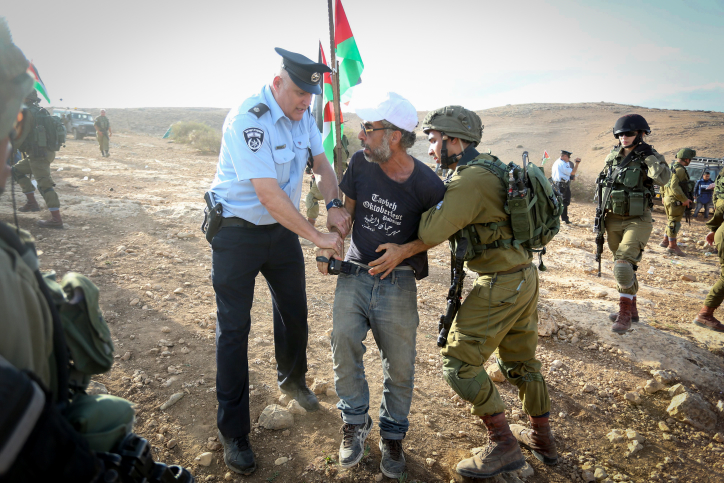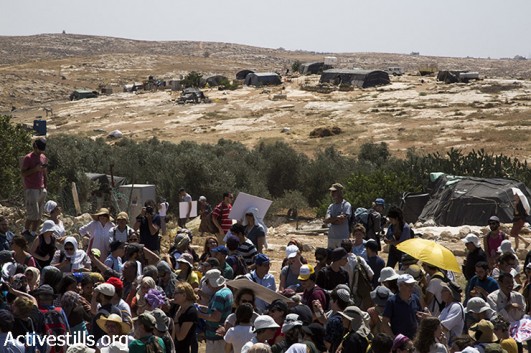So far this year, the IDF has demolished 349 structures, displacing 542 people and 302 children. Israeli human rights NGO B’Tselem warned in August that the expulsions would constitute a war crime.
By +972 Magazine Staff

The Israeli army ordered the eviction of 300 Palestinians from their homes in the northern Jordan Valley area of the occupied West Bank earlier this month. The residents of Ein al-Hilweh and Umm Jamal, who mostly make their living herding sheep, camels, and cows, have lived in the area for decades. The IDF and its Civil Administration, Amira Hass reported in Haaretz, is taking similar steps to evict three other Palestinian communities in the northern Jordan Valley: Kalat Makhoul, Al-Farisiya, and Khumsa.
For years, Prime Minister Benjamin Netanyahu has insisted that Israel will retain control of the Jordan Valley in any two-state solution, a condition that would undercut the sovereignty of a future Palestinian state. The Palestinians and even American negotiation teams have rejected this demand.
The latest orders are part of a larger trend of evictions and demolition orders issued to Palestinians living in Area C, the 60 percent of the West Bank where the Israeli military controls not only security but also civil matters. Palestinians are prohibited from building on around 70 percent of the land in Area C, most of which is designated for Israeli settlements and military use, and it is virtually impossible for Palestinians to obtain building permits in the remainder of the territory.
In the village of Khan al-Amar, located east of Jerusalem, 173 people, including 92 children, live under threat of eviction. In late August, Israeli Defense Minister Avigdor Liberman announced that the army would remove the village in a matter of months. Khan al-Amar is also home to a mosque and a school, built in 2009, that serves over one hundred children from around the area. Israel refuses to connect the community to the power grid or provide basic infrastructure services and most structures in the village have been issued demolition orders. The army recently announced its plan to relocate the residents of Khan al-Amar, as well as the school to a site near the Abu Dis garbage dump.

In the South Hebron Hills, the residents of the village of Susiya also face eviction. Susiya is home to around 200 people, including 93 children. The village has been under threat of demolition for many years, and the army has razed numerous structures there. Susiya was the site of large protests in 2012 that brought to together Palestinian committees from around the West Bank, Israel anti-occupation groups, and international activists, and turned the village into a symbol of non-violent resistance. Western governments have frequently protested Israel’s plans to displace the community.
Figures published by the United Nations Office for the Coordination of Humanitarian Affairs (OCHA) show a sharp, recent increase in demolitions and displacements in the West Bank. In 2016, Israel demolished 1094 structures, displacing 1601 people and 406 children. So far this year, 349 structures have been demolished, displacing 542 people and 302 children.
In August of this year, Israeli human rights group B’Tselem warned the Israeli government that expelling the residents of Khan al-Amar and Susiya and demolishing the villages would constitute a war crime:
Under International Humanitarian Law, which Israel is obliged to respect in all its actions in the West Bank, all Palestinian residents of the West Bank are considered “protected persons”. This status entitles them to the protection of the occupying power, which is bound by numerous rules and restrictions that limit its actions in the occupied territory. One of these restrictions is the prohibition on forcible transfers of protected persons inside the occupied territory, or their deportation outside the occupied territory, regardless of the motive. Forcible transfer is a grave breach of the Fourth Geneva Convention and constitutes a war crime.
Earlier this week, the Association for Civil Rights in Israel (ACRI) sent a letter to Gen. Roni Noma, commander of IDF forces in the West Bank, calling on him to cancel the evacuation orders issued to the residents of Eil al-Hilweh and Umm Jamal. The letter stated that the orders would violate International Humanitarian Law.
